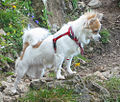Zamperl
As Zamperl in is Bavarian language area as well as in parts of Baden-Wuerttemberg a small dog called.
meaning
A Zamperl is a dog that meets one or more of the following criteria:
- He belongs to a short, mostly lively breed of dog.
- He is still in the puppy stage . In this case, dog boys of large breeds are (still) referred to as Zamperl.
- He's not thoroughbred. However, these dogs are more often referred to as Stiangglanda (= stair railing) - mixed breed . The reference to the "banister" indicates that the breeding conditions of this animal did not meet the criteria of traditional dog breeders' associations. The spelling dictionary also defines this term as a Bavarian expression for a non-purebred dog. This cannot be confirmed in this exclusivity. A Bavarian Zamperl can, but does not have to be, a mixed breed dog.
Large dogs that are perceived as dangerous are generally not referred to as Zamperl. The same applies to working dogs of all kinds (e.g. guard, herding, hunting, guide and attack dogs ). The dog breed of Dachshund / Dachshund / Teckel is an exception. They were originally bred for (badger) hunting. The (or the) Zamperl serves people as a life companion and often achieves the status of a family member.
Occasionally even toddlers who are just making their first attempts at walking are called by their caregivers with the nickname "Zamperl".
The archetype of Zamperls, the black-haired Munich Dachshund is ( "Beer Dachshund"). Since the 1980s, however, it is in terms of popularity increasingly from Rauhaardackel displaced. The dachshund, sometimes referred to as “Wurst mit Haxn ” or “Sausage Dog”, is said to be resistant to upbringing, stubborn, stubborn, but still fond of children, cuddly and lovable. In 1972, the Munich Olympic year, the typical Zamperl was used as the mascot for the 20th Summer Games in the Bavarian capital.
origin
The etymology is not clear. Two possibilities are discussed:
- According to Marianne Küpper's dictionary of colloquial German , Zamperl is a non-purebred dog. According to their interpretation, the word derives from pounding = tripping with impatience .
- In the doctoral thesis Romanisms in Bavarian: An Annotated Dictionary by Isabel Alexandra Knoerrich, the term is traced back to the Italian word Zampa for paw and means nothing more than small dog . The same opinion is the English linguist Anthony Rowley in a time -Article of of 2004.
Zamperl in literature and music
- Around 1830 Johann Nestroy composed an opera parody with the title Zamperl .
- The Viennese actor Hans Moser (1880–1964) wrote Das Lied vom Zamperl (text: Loibl, music: unknown), in which he sings about visits to various wine bars accompanied by his Zamperl.
- The Upper Bavarian music cabaret artist and author Jörg Maurer dedicates a multi-page chapter in his book Bayern für die Hosentasche to Zamperl. In it, he describes the Zamperl as a dog that, with its hopelessly sad eyes, mourns its long-forgotten existence as a hunter . A little further, Maurer describes the Dackelzamperl as a lion who has degenerated into a loyal plaster waddler , but which still carries some remnants of its snapdragon strength and grandeur .
Curiosities
In the Bavarian capital of Munich , building tenders for public drinking fountains required Munich- specific versions with dog drinking bowl (s). Below is an excerpt from application No. 1049 of the city council group DIE GRÜNEN / RL dated August 6, 1998:
The building department obtained documents and sometimes models from manufacturers in Germany, but also in Europe. The building department currently has eight offers or documentation on drinking fountains, of which, if not already available, models modified for Munich (with "Zamperltränke") on a scale of 1: 5 are being built.
Until the end of the 1990s, there was a non-urban drinking fountain in Munich exclusively for dogs. In the pedestrian zone (Neuhauserstraße) a wooden sign showed the way to this (somewhat hidden) “Zamperl drinking place”.
There were also numerous drinking points with integrated dog troughs in public places. Most of the time they carried a riveted brass plate, which showed the name of the founder of this drinking water point. In the second half of the 20th century, most of these facilities disappeared from the streets. A few survived as rarities in museums or ended up as eye-catchers in the entrance areas of department stores.
In Munich, more than seventy ornamental fountains , which are actually intended as architectural enrichment, carry pure drinking water. Some of them, such as B. the fish fountain at Marienplatz are equipped with a "Zamperl drinking point".
In the district capital of Dachau , northwest of Munich, there has been a traditional (private) Zamperl drink on Münchener Straße for several years.
Trivia
The ultimate team of TSV Unterföhring in the district of Munich gave itself the name “Zamperl Unterföhring” based on ice hockey teams that call themselves “Tigers”, “Polar Bears” etc. They appear under this name in game boards and winners lists.
Typical zamperl
West Highland White Terrier ( Westi )
Individual evidence
- ↑ Knoerrich: Romanisms in Baierischen . d-nb.info
- ^ Antony Rawley - The British Bavarian . In: Die Zeit , No. 11/2004, p. 36
- ↑ Jörg Mauer: Bavaria for your pocket: What travel guides hide . 1st edition. Fischer Taschenbuch, Frankfurt am Main, 2016, ISBN 978-3-596-52101-2 , pp. 186 ff.












